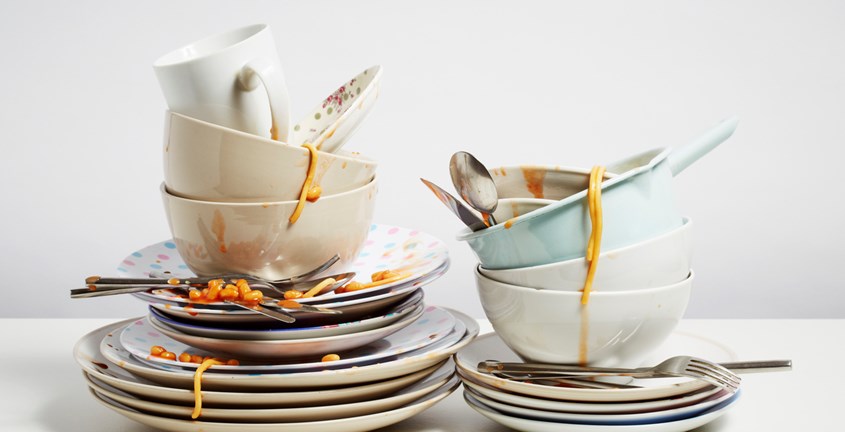Part 2 - Environmental Health - Are you doing it right?
Part 2 - Environmental Health - Are you doing it right?

The last time I blogged about the benefits of a colour coding system, and how having all areas assigned a colour ensures clarity in terms of which mop is to be used where just makes maintaining hygiene standards a lot easier. Just recapping really quickly these are the colours and the zones which they should be attributed to.
This blog is about an equally important and quite a contentious issue how to wash your dishes the correct way (yes there is a correct way)! Simple right? Well no it’s not really that simple so please do bear with me while I guide you through this. This is so important!
Over the past few years there has been so much discussion about the correct way to wash and to sanitise a dish, and hygiene suppliers have kind of led a lot of people up the garden path about this topic, so I wanted to truly bottom this out and dispel all of the myths.
So are you doing it right? That is the question?
In the not so distant past, food handlers believed that you could wash a dish and sanitise it in one go in a kitchen sink. They also believed this could be done with a really lovely luxuriously bubbly solution like the type you’d get from a well known domestic washing up liquid with a baby on the front (no guessing now!). Sadly this has never been true and is not true today. Not even the well known washing up liquid with the baby on it which says it is antibacterial and also has ‘Professional’ on it will impress your Environmental Health Officer (EHO) because it doesn’t meet the standard……….read on.
The only fool proof way to easily wash and sanitise your dishes in an easy and fuss free way is to put it through a correctly calibrated commercial dishwash machine. This dishwash machine will inject the correct amount of machine dishwash (which is a highly caustic and acidic solution) and mix it up with very hot water causing the dishes inside to not only be stripped of the soil and food bits, but also thermally disinfected. So under such hot conditions the bacteria on those dishes does not stand one iota of living, and dies on contact with that very hot water. This is without doubt the most effective solution. Also, we are removing the human factor here, and humans are sadly the ones to mess up processes when we go to such pain staking measures to put them in. So commercial dishwashers are a winner for you and for environmental health.
If you cannot fit the large pots through your dishwasher, or are in the unfortunate position that you don’t have a commercial dishwasher you need to be reading this blog like it is the holy grail! You absolutely must use an appropriate chemical to not only wash your dishes, but also to sanitise them. The most important thing you are looking for is something which is going to kill bacteria in water – which is of course different than a hard surface. There has been a lot of discussion with the introduction of new guidelines from Europe, but to be on the safe side you should be using a two stage process in dishwash washing a dish sanitising.
Stage 1: General cleaning using a detergent. This involves the physical removal of visible grease, dirt and food particles from surfaces and equipment, followed by a thorough rinse to ensure the removal of all residues from the surface. We recommend the use of our 10% Detergent which is a washing up liquid which will remove all of the soil from your dishes. Get it by clicking here!
Stage 2: Disinfection This involves the use of a disinfectant following the manufacturer’s instructions for its dilution rate and contact time. Disinfectants will not be effective if used on dirty surfaces, or if applied at the incorrect dilution or for the insufficient contact time or the incorrect temperature. We recommend this bactericidal detergent which can be purchased here. When using a Bacteriacidal Detergent the most important thing is that it must kill E-Coli and other harmful bacteria – which this one does.
It is of uber importance that you know exactly how much liquid you sink takes to calculate your dilution rate – so measure it out! This is like info 101 your EHO wants to see, so fill up a 5 litre with water and pour it in to your sink with the plug in. If you put 15 litres in, 20 litres in, mark it on your sink with a permanent marker so that your EHO can see you totally have the basics covered -you know how much water your sink takes. I know this sounds so basic – but you would be surprised how many people do not know this! The dilution rate for our recommended Bactericidal Detergent is 1:100 – so one part chemical to 100 parts water, so for a 20 litre sink that equates to 200ml. Get a 25ml pelican pump and put 8 squirts in your sink for a perfect dilution rate. Make sure your water is hot enough but not too hot, put your 8 squirts of chemical in, and leave your dishes to soak in your perfectly calculated sanitising solution for 5 minutes.
Then simply pull them out of the liquid and leave them to dry. Do not contaminate them again, by rubbing them with a tea towel – no sir do not do that! Use your common sense and keep them off the floor, leave them to dry on a clean and sanitised surface (point 3!) and then put them away on a clean and sanitised shelf!
Next week I’ll be blogging about how to sanitise a surface and all the pitfalls and unclear information about this issue. Thanks for reading!


Comments
Post a Comment